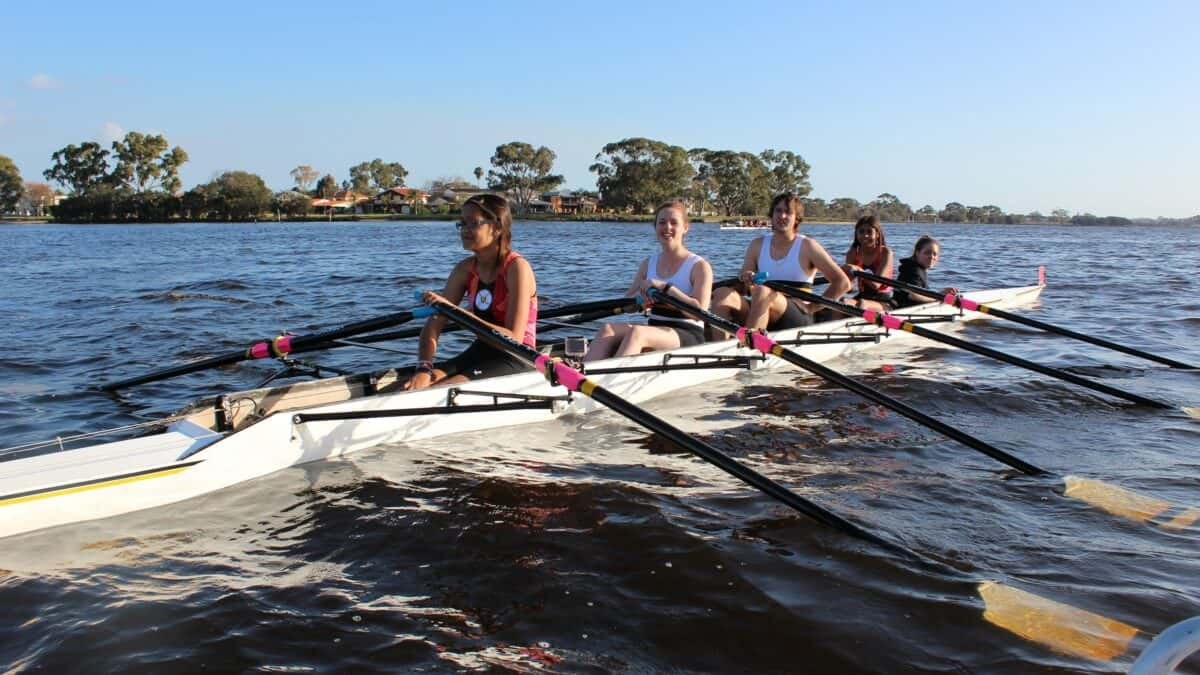
23 Nov 2015
Curtin University - Breaking barriers through rowing and education
Now in its second year, the Row AHEAD initiative has brought educational engagement to a community underrepresented both within Australia’s system of higher education and the sport of rowing. The twelve-week programme combines rowing and academic mentoring to empower aborigine students at the nearby Clontarf Aboriginal College to create opportunities that many would never have considered possible.
Row AHEAD is part of the larger Curtin AHEAD (Addressing Higher Educational Access Disadvantage) initiative of the university and state government. Their website states the mission as “a collaborative and innovative outreach programme that grows the potential of groups and individuals that are under-represented in higher education.” The AHEAD programme “aspires to open the idea of the benefits of education by raising awareness and understanding of the long-term benefits of higher education.”
“I like to think that it is authentic reconciliation, says Cameron Thorn, Team Leader for Curtin AHEAD and President of the Curtin University Boat Club (CUBC). “It is empowering for the students to engage in a sport that has otherwise been inaccessible due to the cost and the availability of the opportunity.”
The idea to use rowing came to Thorn and CUBC Head Coach Aiden Smith on their drive to practice. “Every morning we drove past the Aboriginal school,” recalls Thorn. “It is just 1,200m from the club and we asked ourselves ‘why haven’t these students been involved in rowing?’” The possible connections with the Curtin AHEAD initiative were apparent.
[PHOTO src=”121951″ size=”mediumLandscape” align=”right”]
“We look at a sport like rowing where,” Thorn explains, “there are barriers to involvement. So why not use it as an engagement tool to promote higher education?”
The opportunity is unique for the students, who had never even considered pursuing higher education, let alone rowing. Current student-athletes on Curtin’s rowing team provide on-water coaching and mentorship in the academic setting of the university. “On the surface,” says Thorn, “they are using these sports facilities, but underneath they are breaking down the invisible barriers just by walking onto campus. Rowing serves as the vehicle to engage them in that conversation.”
“The main thing,” Thorn emphasises, “is making sure the students feel confident and comfortable engaging in that space.” Thorn has witnessed this transformation as these students’ initial hesitations shift to excitement, ownership and pride in a part of society that they have remained for too long on the fringe.
As for success, Thorn believes it is subjective. “A lot of these students were disengaging from education and other things in their lives,” say Thorn. “Last year we started with one afternoon session a week and this year we began with two. Some students began to ask if they could come down in the early morning when other teams were training. It was incredible to see these students get up in the dark and cold of June of their own accord in order to row. I’ve seen students who don’t have the ‘traditional’ rowing body type, but build confidence to go back to class and engage in learning and put up their hand to ask questions.”
“Shame is a big cultural issue here for indigenous people,” Thorn continues. “We had the opportunity for students to design their own zootie (unisuit) and wear it proudly in frot of their peers and the media.” The attitude and the conversation has changed to one of engagement and possibilities as students discuss their desires to enter fields of higher education like health science as a direct result of this initiative.”
The CUBC has a long history of pushing beyond contemporary social customs by reaching out to underrepresented populations. This progressive tendency has taken several forms over the years. The inclusion of women on a level basis with men in the team’s early years after the club’s founding in 1969 demonstrated a clear stance on equality. The CUBC was the first club in Western Australia, and one of the first sports at Curtin, to do so.
The Curtin rowers were also pioneers in para-sport, working in the early 1970s with the Braille Society to provide access to rowing for six athletes with visual impairment. Thorn explains how they had special stable boats built where the coxswain could stand up and walk around to make physical corrections to technique.
“It is pretty amazing,” says Thorn, “some of the things that the past committees were able to do.”
The CUBC’s status as a stand-alone entity beyond the university itself, has contributed to a broad membership that currently includes the local public school teams, masters, and of course the university team, who constitute the majority of the membership. The Row AHEAD programme has been well received and supported by all of the rowers at the CUBC.
Thorn, who recently completed his Bachelor of Education, was elected President of the CUBC this year and hopes during his term to build sustainability into the club’s programmes including Row AHEAD.
“I have started a Masters of Philosophy in Education,” says Thorn, “and want to research what impact experiential education can have on engagement. I can use this Row AHEAD programme as an example of how it can lead to increased engagement of the participants in the rest of their education.”
Thorn has some new rowing goals in mind as well. “A dream of mine would be to take an all-indigenous eight to participate in the Henley Royal Regatta,” he says. “It would be an incredible achievement for the students and all indigenous people.”
World Rowing will take a look at different university club programmes to find out what makes them unique and what elements have contributed to their success. If you think your university should be profiled, please contact us and tell us what sets your team apart: media@fisa.org

